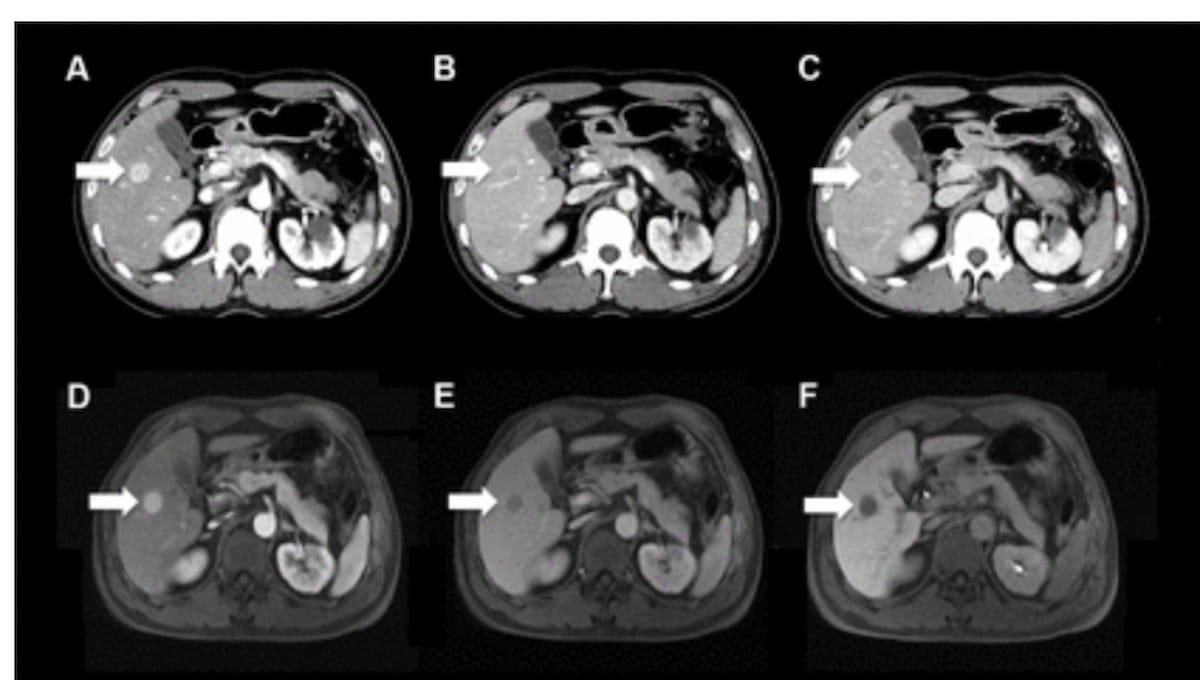Emerging research suggests that Liver Imaging Reporting and Data System (LI-RADS) category 5 (LR-5) assessment of computed tomography (CT) and magnetic resonance (MRI) scans has greater than 96 percent accuracy for detecting hepatocellular carcinoma (HCC) in patients with non-cirrhotic chronic hepatitis C (CHC).
For the retrospective study, recently published in Radiology, researchers compared the use of LR-5 for detecting HCC in 239 patients with cirrhotic CHC and 219 patients with non-cirrhotic CHC. The total cohort included 350 men and had a mean age of 64, according to the study.
Overall, the study authors found that LR-5 assessments demonstrated a 77 percent accuracy rate, 74 percent sensitivity, 95 percent specificity, 99 percent positive predictive value (PPV) and a 40 percent negative predictive value (NPV) for HCC.
However, in validation testing for patients with non-cirrhotic CHC, the researchers noted substantially higher accuracy (96.1 percent), sensitivity (82.9 percent) and NPV (95.2 percent). The study authors also pointed out an 11 percent higher AUC for LR-5 assessments in non-cirrhotic CHC cases (90 percent) in contrast to those with cirrhotic CHC (79 percent).
“Crucially, it is reported that up to 20% of all HCCs originate in noncirrhotic backgrounds, including those infected with (hepatitis C virus) HCV. These often manifest with typical histopathologic and radiologic features. … Given the remarkably high rates of HCV clearance achieved by contemporary antiviral therapies, moving forward, the ability to diagnose HCC accurately and noninvasively will likely become increasingly critical for cured patients without LC,” wrote lead study author Jihyun An, M.D., who is affiliated with the Department of Gastroenterology and Hepatology at the Hanyang University College of Medicine in Guri, South Korea, and colleagues.
While the researchers noted a 66 percent incidence of HCC in patients with liver cirrhosis, they indicated a 23 percent prevalence of HCC for individuals with non-cirrhotic CHC.
Multivariable analysis also revealed that tumor size > 2 cm had 192 percent higher association and solitary tumor presentation had 132 percent higher association with LR-5 assessment for HCC.
“The high proportion of single lesions in our test dataset (90% of patients) provided a near one-to-one correspondence between image-detected lesions and resected specimens, enhancing the reliability of the radiologic-pathologic correlation. These findings were consistent even in patients with F0–F2 fibrosis, who are not typically considered candidates for HCC surveillance according to international guidelines,” added An and colleagues.
Three Key Takeaways
1. High accuracy of LR-5 in non-cirrhotic CHC. The Liver Imaging Reporting and Data System (LI-RADS) category 5 (LR-5) showed over 96 percent accuracy in detecting hepatocellular carcinoma (HCC) in patients with non-cirrhotic chronic hepatitis C (CHC), highlighting its potential for reliable non-invasive diagnosis in this population.
2. Differences between cirrhotic and non-cirrhotic CHC.
LR-5 assessments had a higher accuracy (96.1 percent vs. 77 percent) and sensitivity (82.9 percent vs. 74 percent) in patients with non-cirrhotic CHC compared to the broader population with CHC. This suggests that current imaging criteria may be particularly effective for detecting HCC in non-cirrhotic patients.
3. Potential shift in HCC surveillance criteria. Given that up to 20 percent of HCC cases arise in non-cirrhotic livers, and with improved hepatitis C virus (HCV) treatment reducing cirrhosis prevalence, expanding HCC surveillance guidelines to include non-cirrhotic HCV patients could improve early detection and management.
Noting challenges with liver tumor biopsies, ranging lesion targeting and distinguishing between lesions and nodular backgrounds to low sensitivity in tumors < 2 cm, the study authors noted that 28.2 percent of the nodules assessed in the study were < 2 cm.
“Our study provides evidence supporting the inclusion of patients with non-cirrhotic HCV as an indication for the use of noninvasive LI-RADS criteria,” said An and colleagues.
(Editor’s note: For related content, see “What is the Best HCC Staging System for People Being Treated with Transarterial Chemoembolization (TACE)?,” “Emerging MRI Scoring System May Help Predict Recurrent and Metastatic Hepatocellular Carcinoma” and “Abbreviated MRI for Hepatocellular Carcinoma: What a New Meta-Analysis Reveals.”)
Beyond the inherent limitations of a retrospective study, the researchers conceded that the findings with a racially homogenous Asian cohort may not be applicable to broader populations. They also noted possible bias due to the lack of independent central imaging review, and evolving CT and MRI technology during the 20-year study period.
